Candy bowls made of newspaper tubes

Hand-made interior items have become very popular. When making them, all available materials and devices are used. This creative process requires a lot of free time, but the result always exceeds expectations. We suggest you make candy bowls from newspaper tubes with your own hands.
Peculiarities
There is one big advantage to paper vine weaving. Paper has a much lighter weight than vine, and products from it are lighter.
Also, the paper vine is more elastic and able to withstand tighter bends., which gives new possibilities for weaving.
This made it possible to manufacture small items.
Paper vine products are elegant and very beautiful.
When tinted correctly, they are very difficult to distinguish from objects made from natural vines. Basically, small items for interior decoration are made in this way.

They complement the atmosphere of coziness and comfort in the home. Below is a master class on making several items from a paper vine.
Newspaper vine vine
The first step is to prepare the paper vine. For beginners, consider making a vine from newsprint step by step.
In this process, the following materials and devices will be involved:
- paper or newspapers;
- stationery knife;
- scissors;
- PVA glue;
- small brush;
- knitting needle with a diameter of 2 mm;
- acrylic lacquer.
So, you need to take a newspaper and cut it along the fold line. On the resulting sheet, mark a strip 7-8 cm wide, and fold it across. Cut along the fold line. You should get a strip 7-8 cm wide and about 30 cm long.


Place a sheet of paper on a flat, hard surface. Take a knitting needle, put it on the edge of the prepared sheet of paper at an angle of 20-30 degrees. Holding a sheet of paper with one crayfish, with the other we begin to wind it on a knitting needle. Gently press the sheet against the knitting needle so that the tube is dense enough.
It is necessary to wind the paper so that the ends of the tube are of different diameters - one slightly larger than the other.
This is necessary for building up a paper vine. It will be inserted with the end of the smaller diameter into the end of the other tube with the larger diameter.



At the end of this process, a small corner of paper should remain, which must be greased with PVA glue and glued to a paper tube wound on a knitting needle. Carefully remove the paper vine from the knitting needle and let the glue dry.
To make a candy bowl, you need about 50 of these newspaper tubes.
There is no need to rush into making such a straw. The tubes must be tight enough for the product to be durable.
For the final readiness, the tubes must be painted.
A water-based stain is ideal for this.


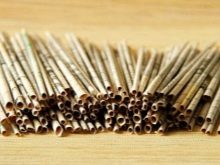
The rich color palette allows you to easily find the right color. It is necessary to take a bunch of paper vine (15-20 pcs.) By one end, and put the other in a container with stain. Then remove, drain the excess stain from the straws and turn over. Repeat the operation with the unpainted end of the paper vine bundle.
After the tubes are completely colored, they must be dried.
It is necessary to catch such a moment when the paper vine will be a little wet. This will give it the best elasticity, which is important when weaving. If the paper vine has dried completely and become hard and inflexible, then you need to sprinkle it with water from a spray bottle.

It is necessary to wet the middle part so that the ends of the vine remain firm.
Cup candy
As mentioned above, to create a cup-candy we need a minimum of costs and materials... This product turns out to be very functional and practical. It will really help to add additional charm, coziness and presence of something home and dear to the tea ceremony.
The weaving of the cup starts from the bottom.
To do this, you need to take four pairs of paper vines and intertwine them crosswise in the center. Smear a little with PVA glue in the plexus places. In what follows, these tubes will be called guides.

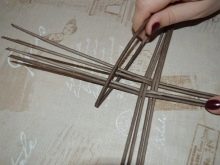
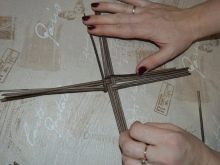
Fold the next paper vine in half and put it on 4 guides. Gently press it against the center of the plexus of the guides (middle of the bottom). We lower the upper half of the tube down and pass it under four adjacent guides. Raise the lower half up and draw on top of the adjacent 4 guides. And so we alternate in a circle. This weaving method is called "string".
As the weaving proceeds, the paper vine will end. To grow a tube, you need to drop PVA glue into a hole with a larger diameter and insert a new vine into it.
From the other end of the straw, it is necessary to do the opposite - drip glue into a new vine and plant it on the thin end of the ending tube. Weave 3-4 rows and separate the paired guides. Now you need to braid each guide.



When the desired diameter of the saucer is reached, leave 1.5 cm on the working vine, cut off the rest. We hide the remaining ends with a knitting needle in weaving.
To make our saucer look finished, we need to close the edge of the weave.
It is necessary to take a guide, bend it towards the adjacent one, make a bend at their intersection and, stepping back 2 cm from it, cut off the remainder. Tuck the resulting tail next to the adjacent guide. Do this with all the guides in a circle.



The bottom or saucer is ready.
Weaving a cup also begins with the installation of guides.
Fold the paper vine in half and push them through the saucer from below. Install them so that the cup guide braids around the saucer guide.Then we bend one tube and put it on the cup guide. We start weaving in the same way as weaving the bottom, only vertically.

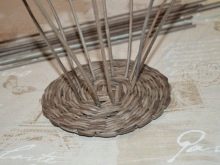

After 3 rows, you need to insert some form for flying around. It can be any dish in the form of a hemisphere.
The guides must be evenly distributed, pressed against the mold and fixed with clips or clothespins at the edges.
The distance between the guides should not exceed 3 cm, otherwise the weaving will be fragile. After reaching the desired height of the cup, finish weaving in the same way as when weaving the saucer.


To weave a handle, you need 3 paper vines.
Put 2 tubes parallel to each other. Glue the third vine to one of them at a distance of 2 cm from the edge. Let it dry. Insert two knitting needles inside between the two tubes for rigidity. With the third vine, we begin to braid the tubes with the needles with eights, stepping back 2 cm from the edge.

We also finish weaving 2 cm before the edge of the vine. We carefully take out the knitting needles, tuck the end of the third vine into weaving and glue it a little.
The braided handle is ready, it remains to attach it to the cup. To do this, using a knitting needle, the left ends of the handle, 2 cm each, are tucked into the weaving in the upper part of the cup guide. We do the same at the bottom. For the rigidity of the structure, we grease these places with PVA glue. Let the cup dry completely.
To give strength to our candy bowl, you need to prime it.
To do this, dilute the PVA glue with water in a 1: 1 ratio and apply the solution with a brush over the entire product.

Dry well and the mug is ready.
Vase
It doesn't take long to weave an openwork candy vase. You need to start with weaving the bottom. After the bottom has reached its size, take 5 guides through one from one side, 5 from the opposite side and lift them up. Secure them together at the top with a clip or clothespin. These are blanks for the future handle of the vase.
To perform openwork weaving, you need to take a paired guide and run it under the adjacent guide.
Then lift up the next rail, lower it down under the other and bring it up. You should get a small semicircle.
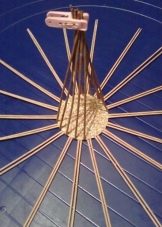



Do this with all the guides. All ends of the rails must point upwards.
To shape the vase, you need to take a 1 liter glass jar and place it on the bottom of the product.
Gently squeeze the netting around the can and turn it upside down. Braid the remaining ends of the guides in three rows with "string" weaving and finish the weaving in the same way as when making the bottom of the cup. This will be the vase stand.



We form the handle of the vase and wrap the upper parts with paper vine. For strength, grease with PVA glue.
Candy bowl with lid
Making a candy bowl with a lid is carried out in exactly the same way as in the case of the previous products. First, you need to weave the bottom of a given size and then bend the guides up. Weave "string" to weave the required height of the candy bowl and finish weaving.

At its core, the lid is the same bottom, only with a small handle in the center for easy opening.
The lid is woven with a diameter slightly larger than the diameter of the candy bowl.
How to make candy bowls from newspaper tubes, see the video below.








